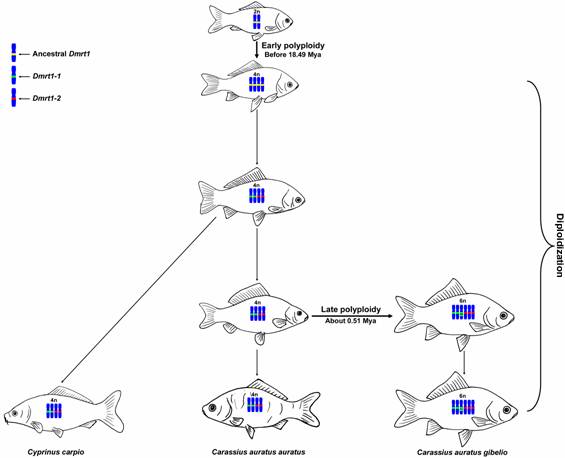
Two Rounds of Polyploidy Origins Revealed in Gibel Carp
Jun 11, 2014 Email"> PrintText Size

Gibel carp (Carassius auratus gibelio), with more than 150 chromosomes, commonly has been recognized as a subspecies of Carasssius auratus with 100 chromosomes. Even though significant advances have been obtained in genetic basis and breeding application, some key evolutionary enigmas, such as the occurrence time and historical process of polyploidy, remain unknown in the polyploid gibel carp.
Recently, two rounds of polyploidy origins in gibel carp have been revealed through analysis of two divergent Dmrt1 genes by the research team of Professor GUI Jianfang at Institute of Hydrobiology, Chinese Academy of Sciences (IHB). Firstly, the researchers identified two divergent Dmrt1 genes and respectively localized the two genes on three homologous chromosomes. Subsequently, the corresponding Dmrt1 genes were also characterized from the closely related species Carassius auratus auratus and Cyprinus carpio, and their two Dmrt1 genes were respectively localized on two homologous chromosomes.
Significantly, the evolutionary relationship analyses among cDNA and genomic DNA sequences of these Dmrt1 genes revealed two rounds of polyploidy origins in the gibel carp: an early polyploidy might result in an common tetraploid ancestor of Carassius auratus gibelio, Carassius auratus auratus and Cyprinus carpio before 18.49 million years ago (Mya), and an late polyploidy might occur from evolutionary branch of Carassius auratus at around 0.51 Mya, which lead to the occurrence of the hexaploid gibel carp. Therefore, this study provides clear genetic evidence for understanding occurrence time and historical process of polyploidy in polyploid vertebrates.
This work was supported by the National Key Basic Research Program of China and National Technology System for Conventional Freshwater Fish Industries. And the paper entitled “Evolutionary history of two divergent Dmrt1 genes reveals two rounds of polyploidy origins in gibel carp” has been published in the journal Molecular Phylogenetics and Evolution.

A schematic diagram of two round polyploidy origins in gibel carp. An early polyploidy might result in an common tetraploid ancestor of Carassius auratus gibelio, Carassius auratus auratus and Cyprinus carpio before 18.49 million years ago (Mya), and an late polyploidy might occur from evolutionary branch of Carassius auratus at around 0.51 Mya, which lead to the occurrence of the hexaploid gibel carp. (Image by IHB)
Gibel carp (Carassius auratus gibelio), with more than 150 chromosomes, commonly has been recognized as a subspecies of Carasssius auratus with 100 chromosomes. Even though significant advances have been obtained in genetic basis and breeding application, some key evolutionary enigmas, such as the occurrence time and historical process of polyploidy, remain unknown in the polyploid gibel carp.
Recently, two rounds of polyploidy origins in gibel carp have been revealed through analysis of two divergent Dmrt1 genes by the research team of Professor GUI Jianfang at Institute of Hydrobiology, Chinese Academy of Sciences (IHB). Firstly, the researchers identified two divergent Dmrt1 genes and respectively localized the two genes on three homologous chromosomes. Subsequently, the corresponding Dmrt1 genes were also characterized from the closely related species Carassius auratus auratus and Cyprinus carpio, and their two Dmrt1 genes were respectively localized on two homologous chromosomes.
Significantly, the evolutionary relationship analyses among cDNA and genomic DNA sequences of these Dmrt1 genes revealed two rounds of polyploidy origins in the gibel carp: an early polyploidy might result in an common tetraploid ancestor of Carassius auratus gibelio, Carassius auratus auratus and Cyprinus carpio before 18.49 million years ago (Mya), and an late polyploidy might occur from evolutionary branch of Carassius auratus at around 0.51 Mya, which lead to the occurrence of the hexaploid gibel carp. Therefore, this study provides clear genetic evidence for understanding occurrence time and historical process of polyploidy in polyploid vertebrates.
This work was supported by the National Key Basic Research Program of China and National Technology System for Conventional Freshwater Fish Industries. And the paper entitled “Evolutionary history of two divergent Dmrt1 genes reveals two rounds of polyploidy origins in gibel carp” has been published in the journal Molecular Phylogenetics and Evolution.

A schematic diagram of two round polyploidy origins in gibel carp. An early polyploidy might result in an common tetraploid ancestor of Carassius auratus gibelio, Carassius auratus auratus and Cyprinus carpio before 18.49 million years ago (Mya), and an late polyploidy might occur from evolutionary branch of Carassius auratus at around 0.51 Mya, which lead to the occurrence of the hexaploid gibel carp. (Image by IHB)
CAS Institutes
There are 124 Institutions directly under the CAS by the end of 2012, with 104 research institutes, five universities & supporting organizations, 12 management organizations that consist of the headquarters and branches, and three other units. Moreover, there are 25 legal entities affiliated and 22 CAS invested holding enterprisesThere are 124 I...>> more
Contact Us

Chinese Academy of Sciences
Add: 52 Sanlihe Rd., Xicheng District, Beijing, China
Postcode: 100864
Tel: 86-10-68597592 (day) 86-10-68597289 (night)
Fax: 86-10-68511095 (day) 86-10-68512458 (night)
E-mail: cas_en@cas.cn

